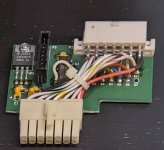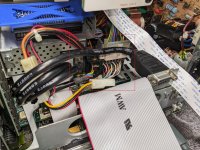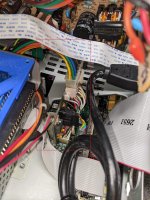KennyPowers
Member
- Joined
- Jun 15, 2021
- Messages
- 44
This "card" is in my Mac Classic:

It plugs into the power/video/sound connector on the logic board and passes it through, and then there's a (quite long) female DB9 cable plugged into it that someone has cut a hole in the back of the case for:


I scoped this thing and traced out the circuit, and it's definitely an external video adapter. I just have no clue what kind of display it's meant to drive. The 9pin connector on the back of the case outputs a positive 22kHz horizontal sync signal on pin 8 and a positive 60Hz vertical sync signal on pin 9. Pin 4 is the monochrome digital video signal. Those pin choices are similar to CGA/EGA, but the sync rates don't match up. They almost match EGA mode-2, but then the vertical sync would have to be negative and mine is positive. Anyone know what kind of display this could have been for?

It plugs into the power/video/sound connector on the logic board and passes it through, and then there's a (quite long) female DB9 cable plugged into it that someone has cut a hole in the back of the case for:


I scoped this thing and traced out the circuit, and it's definitely an external video adapter. I just have no clue what kind of display it's meant to drive. The 9pin connector on the back of the case outputs a positive 22kHz horizontal sync signal on pin 8 and a positive 60Hz vertical sync signal on pin 9. Pin 4 is the monochrome digital video signal. Those pin choices are similar to CGA/EGA, but the sync rates don't match up. They almost match EGA mode-2, but then the vertical sync would have to be negative and mine is positive. Anyone know what kind of display this could have been for?
